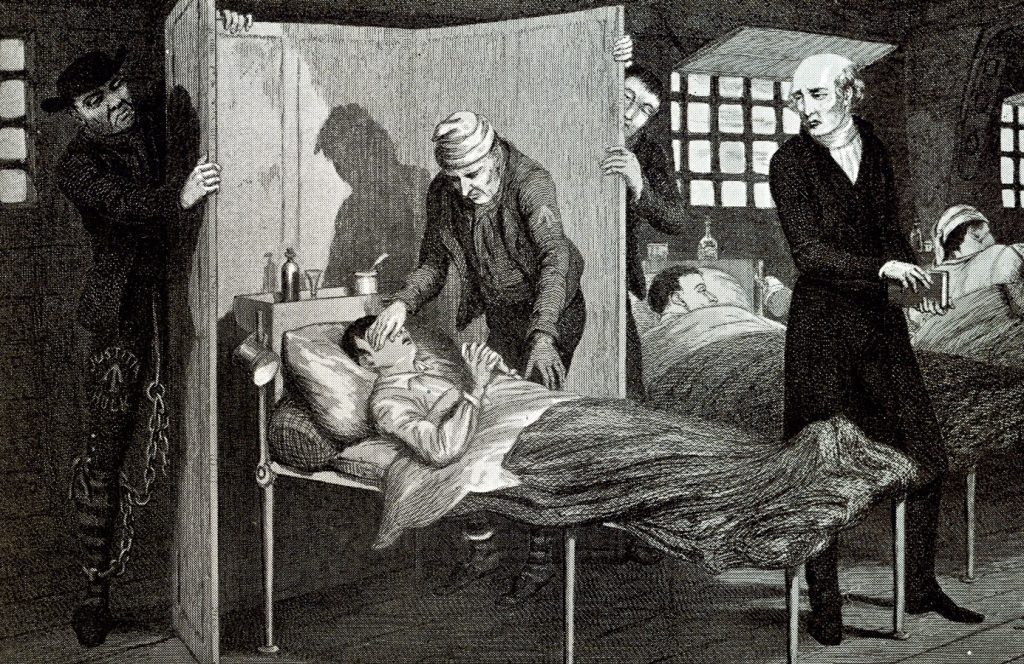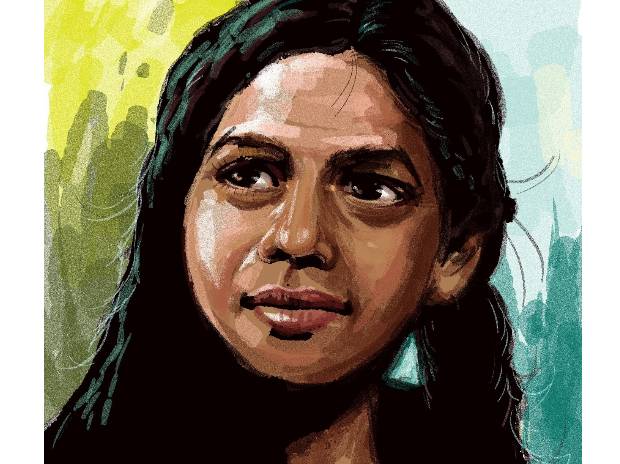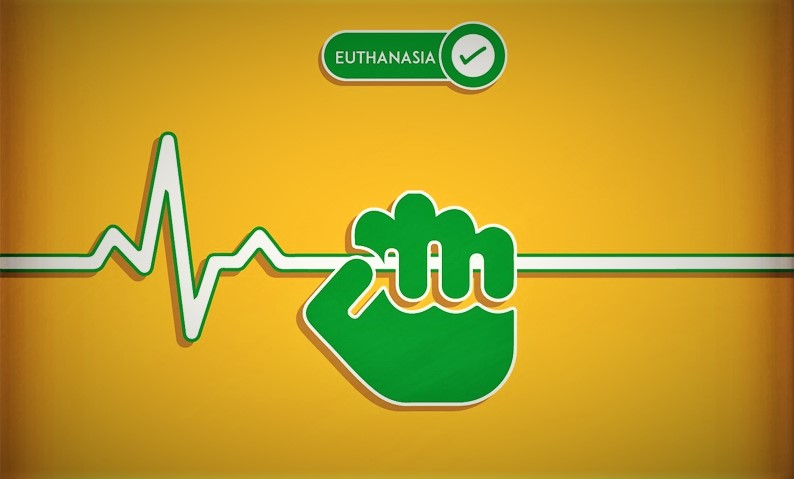
Euthanasia as a concept has been incorporated with terminally ill patients so much, that it has become a norm to imagine someone lying on their ‘death bed’ wishing for a quick release from a prison called ‘life’. But it is not so, as a concept, euthanasia has always been ignored and looked down on upon by society. It is an outlandish concept that has become an outcast in the ocean of rights guaranteed by our constitution. Why is it an outlandish concept? Because we humans have almost always cherished our lives, we are taught to make the most out of the time we get as sentient beings. But we as a race have forgotten that the ultimate goal of life is Death. We treat Death as something avoidable, but it is in-fact the inevitable.
It is a fact that for a person nearing his time in this world, prolonging pain and suffering would be inevitable. With the medical advancements, the average human life expectancy has gone up and despite all the plagues and pandemics, human beings have become resilient as a species to most of the diseases. But science has yet not advanced to a stage where it can grant us immortality or make everything bearable for us, with pain ultimately ceasing to exist. It is this grey area where a human being feels pain only described best by emotions and not words, and with the knowledge that his/her time on this planet is up, chooses to refuse further treatment to prolong the inevitable suffering and ends their own life. Euthanasia is the termination of a life by choice.
The Dilemma
Euthanasia has been flagged as unlawful and against the public policy of India for a long time. Recently, the Supreme court in a 2018 Judgment declared Passive Euthanasia as a legal practice. We shall look into the judgment and the types of euthanasia as go further into the article, but for now, it is important to understand why is Euthanasia such a sensitive topic.
The dilemma arises out of two opinions. One opinion suggests that such a practice is not allowed in law and would defeat the purpose of Article 21 of the Indian Constitution which guaranteed the right to life, the other opinion is that such a practice is immoral and not ethical.
The Morality of choosing Death
Euthanasia is subjected to a lot of criticisms. While the state argues expressly that it is against the norms and conducts of the state itself to allow death, it would also place a burden on the responsibility of the state to ensure lawful euthanasia. Life in India (as well as almost everywhere in India) is termed to be a gift of God. A sacred sentient life that should be preserved and utilized to the maximum.
The argument presented against such claims of life being a God’s gift is if you cannot provide for yourself or have lost all sort of utility and mobility to actually benefit and utilize the life, leading to life sans dignity, would a person be allowed to take their own life? The answer is no. A person in a similar state would not be allowed to proceed with taking their own life. Medical/Clinical Euthanasia is considered ethically wrong for medical personnel who take a ‘Hippocratic Oath’ to never take the life of a patient. In such cases, the true power to decide whether euthanasia would be allowed or not is given to the Court.
Aruna Shaunbaug Case
A similar situation occurred in India when the lt. nurse Aruna Shaunbaug was strangled and sodomized by a sweeper in the hospital she worked. The act of strangulation left her body deprived of oxygen leading to a vegetative state. The court in its decision was firm to state that the constitution does no in fact empowers a citizen to have a right to die/death. The court was faced with the task of answering the question of whether a person in a persistent vegetative state (PVS) could discontinue having life support?
The question was the first of its kind to be asked legally as the parliament/state/courts were not bothered before to clarify on the subject. The patient in the case was in a state of coma for 35+ years. The court held that the patient was not ‘brain dead‘ and continued performing minimal and minuscule activities that proved that she was not ‘dead’. The court allowed euthanasia for brain dead patients or who could no longer sustain themselves naturally and required complete mechanical support to live despite having lost consciousness.

The court concurred on the fact that such a decision to discontinue the life support of the patient in the case or in similar scenarios, it would be best to delegate such decisions to parents, spouse, close relative or next friend or the attending doctor. The petitioner in this case merely knew the patient for a few years and did not satisfy the court’s conditions. The court turned to the hospital staff who had taken care of the patient in an admirable fashion for as long as the patient was in a coma to give a decision. The hospital was against the decision to continue the patient’s life support.
The court further clarified that the hospital would have to appeal to the court for the matter if in the future they wanted the same relief as the petitioner of this case.
Ethical Dilemma
The Aruna Shaunbaug case indicated the hidden ethical dilemma of euthanasia that was not addressed by society. The case indirectly highlighted the dilemma faced by medical professionals in assisting a person to take their own life. As was mentioned above, doctors and other professionals take an oath to not intentionally or voluntarily kill a patient. This meant that doctors and other medical professionals are programmed to give treatment to a patient if it means saving their life. Medical professionals cannot be asked to not treat or assist in a patient’s death. It is simply against their ethical and professional code of conduct.

While euthanasia currently is regarded as the only viable option for a patient when all the advancements and treatments available in the medical profession have been exhausted and no care/cure is available, the patient can choose to terminate their own life if no signs of ‘better life’ are available. Under the common law system, the morality of such practices was always questioned and euthanasia was termed as ‘Intentional Homicide’ which was deemed to be an act out of mercy and pity, and was criminalized and was second to murder in terms of the degree of offenses. As Neil Gorsuch explains, ‘courts have treated the victim’s consent and the killer’s motives at most as reasons to mitigate the defendant’s punishment.’
Modern understanding
Recently, the Court adopted the concept of an ethical dilemma and molded it into a secondary concern in a bigger picture of rights violation. The Court has taken into consideration two approaches in terms of ethical-medical dilemma. The first being the ‘Hippocratic Oath’ that is taken by medicos to fulfill their duty and not take the lives of their patient, in such circumstances a patient asking to withdraw a treatment that does not affect an irreversible situation would not be the same as a doctor voluntarily refusing treatment.
Secondly, in the scenario Passive euthanasia did become legal, the ethical obligation would be secondary to the fact that a person would have the right to die with dignity. In such a case, prolongation of a patient’s life without any purpose would essentially negate the fears and opinions a doctor might have. In this scenario, it would be a legal right being placed higher than an ethical code of conduct of medical professionals.
Legal Dilemma
It is a contention of those who support euthanasia that each and every individual has a right to make or choose a decision when to living. In particular, the argument relates to Article 21 which ensures that each and every citizen gets the right to live with dignity. If and when, can an individual decide to end their life as death seems inevitable? This is claimed as a Right to die with dignity. The State has although claimed that ‘the right to life does not include the right to die and, in any case, the right to live with dignity guaranteed under Article 21 of the Constitution means availability of food, shelter, and health and does not include the right to die with dignity.’
P.Rathinam Case – Section 309 of IPC
The legal dilemma has its origins in section 309 of the Indian Penal Code, 1860. The section deals with the attempt to commit suicide and punishes offenders with a fine or imprisonment. The dilemma is best explained in the case of P. Rathinam v. Union of India. In this case, the court was posed with the issue of the constitutional validity of section 309 of IPC as it was stated that it violated Art. 14 and 21 of the Indian Constitution. The court also decided on matters such as a person’s right to die, public policy regarding suicide, and certain contentions regarding the effects of Art. 21 on such matters.
The court in the said case affirmed that statues, articles, etc. have a negative and a positive effect. Art 21 similarly has a positive effect i.e, it guarantees the right to life with dignity while it also has a negative effect i.e, the right to die or terminate one’s life. This ultimately led to section 309 being decriminalized and removed from the IPC as the court deemed it ultra vires the constitution as Art. 21 cannot be interpreted to mean the right to live a forced life. If someone wants to end their own life of their own free will and accord, they can do so.
Gian Kaur case – Article 21 does not include ‘Right to Die‘
However, this decision was soon overturned in Gian Kaur v. State of Punjab, where a constitutional bench declared that ‘sanctity of life‘ should be preserved and that Art.21 cannot within its ambit construe the meaning of the right to life as also having the right to die. The bench went on to state that a person in PVS can choose for termination of his/her life as it would only count as an ‘accelerating conclusion‘ to what is inevitably death.
Such views of the court were based on a lack of understanding of victimology. These views of the court did not foreshadow what was about to come but instead helped by bringing a widespread discourse regarding the subject.
241st Report of the Law Commission of India on passive euthanasia
It was after the Aruna Shanbaug judgment, that the concerned commission was formed. The commission in its report titled ‘Passive Euthanasia – A Relook‘ dealt with the issue of euthanasia and provided much-needed insight into the concept. This insight unlike the previous reports and judgments was much more rational and adopted the view from a victim point. The report placed reliance on the fact that there needs to be a rational and more humanitarian outlook in such matters. Giving examples from various countries where passive euthanasia is allowed, the report was quick to point out that it is in the ‘best interest of the patients.’
A slippery slope
Legalizing euthanasia has been recognized by the state, society, and even the courts to be a slippery slope argument. The argument being that the authority to take the life of the person would be the decision of a parent, spouse, relative, friend, or a doctor/medical professional and that this authority would be misused for morally wrong acts. Under the pretext of voluntary termination of life, there could easily be a hidden malicious intent of a person benefitting from the death of a person unable to voice or express their opinions in a state of PVS. This is a valid argument against the legalization of such a practice which could potentially lead to high rates of legal euthanasia being conducted at the expense of morally wrong intent and overshadowing the purpose and intent of such enabling legislation.
A solution is executing a living will before any such treatment starts by the patient declaring conditions of euthanasia and any future wishes regarding their medical treatment. It is although again not fail-proof.
Active and Passive Euthanasia

It is important to understand that euthanasia has its own types and conditions. The discourse in India is on passive and voluntary euthanasia. Even involuntary passive euthanasia is acceptable under safety guidelines. It is to be noted that active euthanasia or assisted suicide in India is illegal and is not part of the discourse.
Active Euthanasia
The practice of intentional termination of a person’s life/ another person’s life through direct intervention. This is a codified crime in India. Such a practice involves introducing a person’s system with drugs to deliberately end their life. Such a practice is rather actively assisted by doctors or someone. This is not legal and has severe legal consequences.
Passive Euthanasia
The practice of intentional termination of a person’s life through indirectly omitting an action or treatment leading to an inevitable death is a passive form of euthanasia. This method does not involve a third-party or a second party actively trying to terminate a life. Merely doing nothing is enough to qualify as passive euthanasia. This is permitted and legal in India.
Conclusion
The Issue of euthanasia in India is overshadowed by worsening political regimes, economical instability, and a host of other political and legal issues, since 2011 when the then government had a mandate to come up with legislation for the subject, they established the 241st law commissions which have since served its purpose but here seems to be no legislation in sight. Courts are the foremost authority on the matter.
The subject of euthanasia is a humane and thought-provoking topic, it could be the reason why political parties have steered clear of such a topic. As clarified in the introduction, life is sacred in India, making a mandate to allow termination of life would be politically bad for publicity. But nations and not just a handful but quite a few that have adopted and evolved this concept into their legal framework. It is by no means easy but it has to be done. Recently New Zealand conducted a smooth public poll for people to vote for/against assisted dying and a majority of 65.2% voted for it. something similar in India could really help people suffering from terminally ill diseases to smoothly go through a legal process and avail their choice of death.
An ancient Greek philosopher, Epicurus beautifully describes the situation and dilemma surrounding the death. Life and the very humane sub-context surrounding euthanasia, he said ‘Why should I fear death? If I am, then death is not. If death is, then I am not. Why should I fear that which can only exist when I do not?‘
Editor’s Note
In recent times, with the increase in cases of terminal illnesses like advanced cancer and AIDS, the concern of palliative care and quality of life issues in patients have become an issue of contention. Parallel to this concern has arisen another controversial issue-euthanasia or ‘mercy–killing‘ of terminally ill patients. Proponents of physician-assisted suicide (PAS) feel that an individual’s right to autonomy automatically entitles him to choose a painless death. The opponents feel that a physician’s role in the death of an individual violates the central tenet of the medical profession. The recent case of Honourable Supreme Court judgment in the Aruna Shaunbag case brought the discussion of whether or not euthanasia should be legal to the forefront. This article talks about the various factors involved in this act, such as an individual’s right to life and death, a doctor’s ethical dilemma of taking a life, the legal dilemma about deciding whether ‘right to live with dignity’ also includes ‘right to die with dignity’ under Art. 21 of the Constitution, the various landmark cases related to the topic, etc.